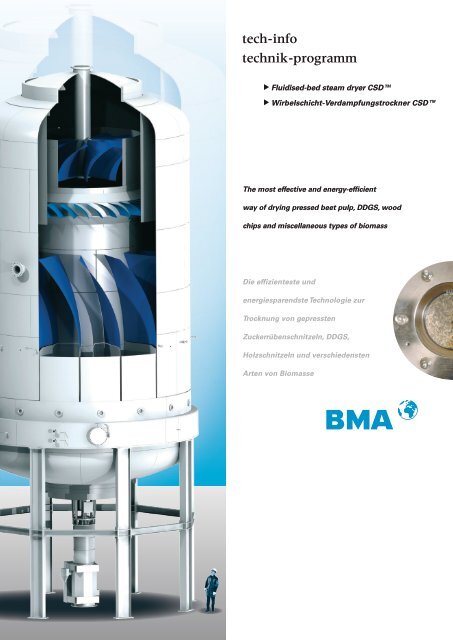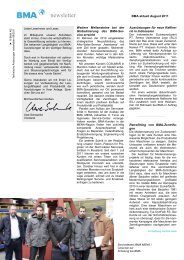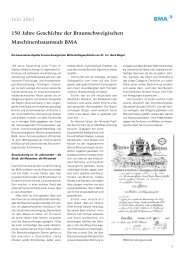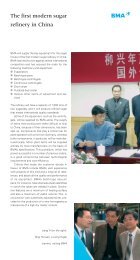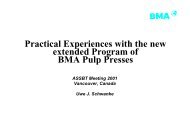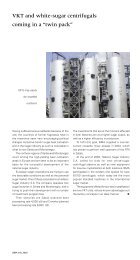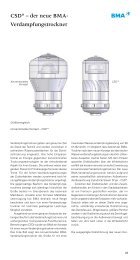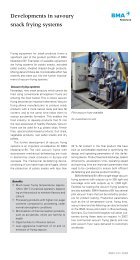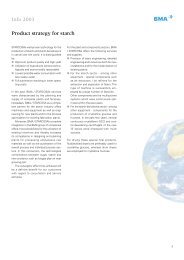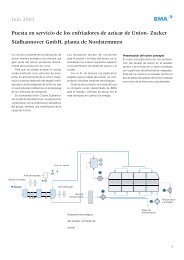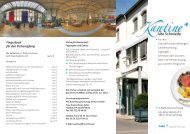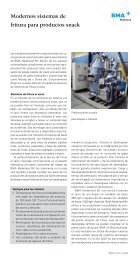technik-programm tech-info - BMA - Braunschweigische ...
technik-programm tech-info - BMA - Braunschweigische ...
technik-programm tech-info - BMA - Braunschweigische ...
Erfolgreiche ePaper selbst erstellen
Machen Sie aus Ihren PDF Publikationen ein blätterbares Flipbook mit unserer einzigartigen Google optimierten e-Paper Software.
<strong>tech</strong>-<strong>info</strong><br />
<strong><strong>tech</strong>nik</strong>-<strong>programm</strong><br />
▲<br />
▲<br />
Fluidised-bed steam dryer CSD<br />
Wirbelschicht-Verdampfungstrockner CSD<br />
The most effective and energy-efficient<br />
way of drying pressed beet pulp, DDGS, wood<br />
chips and miscellaneous types of biomass<br />
Die effizienteste und<br />
energiesparendste Technologie zur<br />
Trocknung von gepressten<br />
Zuckerrübenschnitzeln, DDGS,<br />
Holzschnitzeln und verschiedensten<br />
Arten von Biomasse
CSD during<br />
installation<br />
CSD während<br />
der Montage<br />
Advantages<br />
Vorteile<br />
<strong>BMA</strong>'s fluidised-bed steam dryers offer<br />
the following benefits:<br />
More than 90% of the energy input for<br />
drying can be utilised in downstream<br />
processes<br />
No air pollution from dust and odours<br />
Improved product quality, because<br />
oxidation and exhaust gas contamination<br />
are avoided<br />
No fire risk, because drying takes<br />
place in superheated water vapour<br />
High level of availability<br />
No loss of product as a result of overdried<br />
edges<br />
Small dryer footprint, owing to a compact<br />
and entirely cylindrical design<br />
Low noise level<br />
<strong>BMA</strong>-Wirbelschicht-Verdampfungstrockner<br />
bieten folgende Vorteile:<br />
Über 90 % der bei der Trocknung eingesetzten<br />
Energie kann in nachfolgenden<br />
Prozessen genutzt werden<br />
Keine Luftverschmutzung durch Staub<br />
und Geruch<br />
Verbesserte Produktqualität durch Vermeidung<br />
von Oxidationsprozessen<br />
und Rauchgas-Kontaminationen<br />
Durch Trocknung im überhitzten Wasserdampfstrom<br />
keine Brandgefahr<br />
Hohe Verfügbarkeit<br />
Kein Produktverlust durch übertrocknete<br />
Kanten<br />
Geringer Flächenbedarf durch kompakte<br />
ausschließlich zylindrische Bauweise<br />
Geringe Geräuschentwicklung<br />
4
Characteristic features and sizes<br />
Merkmale und Baugrößen<br />
Sizes Baugrößen 7 8 9 10<br />
Water evaporation rate Wasserverdampfungsleistung t/h 37 49 61 80<br />
(heating steam pressure absolute 26 bar) (Heizdampfdruck absolut 26 bar)<br />
Motor power Motorleistung kW 1000 1250 1600 2400<br />
Diameter Durchmesser m 7,0 8,0 9,0 10,0<br />
Height, approx. Höhe ca. m 22,5 23,5 24,5 25,5<br />
Sizes 3 and 5 upon request<br />
Baugrößen 3 und 5 auf Anfrage<br />
With its revised range of CSD sizes,<br />
<strong>BMA</strong> offers its customers various steam<br />
dryers for a broad spectrum of requirements<br />
(see above).<br />
The electric power consumption of<br />
the standard CSD sizes has been optimised.<br />
For special requirements, the<br />
water evaporation rates of the standard<br />
sizes can be increased by raising the<br />
volume of the circulation steam. For this<br />
purpose, a more powerful motor with a<br />
specially designed fan impeller has to be<br />
installed.<br />
1<br />
90<br />
80<br />
70<br />
60<br />
50<br />
40<br />
30<br />
20<br />
10<br />
Mit der aktualisierten Baugrößenreihe<br />
bietet <strong>BMA</strong> eine Palette von CSD an,<br />
die einem breiten Anforderungsspektrum<br />
gerecht wird (s. oben).<br />
Den Standard-Baugrößen liegt ein<br />
optimierter elektrischer Leistungsbedarf<br />
zu Grunde. Für spezielle Anforderungen<br />
besteht die Möglichkeit, die Wasserverdampfungsleistungen<br />
der Standard-<br />
Baugrößen durch Erhöhung der Zirkulationsdampfmenge<br />
zu steigern. Dies<br />
geschieht durch Installation eines leistungsfähigeren<br />
Motors in Verbindung mit<br />
einem speziell ausgelegten Ventilatorrad.<br />
Size 10<br />
Baugröße 10<br />
Size 9<br />
Baugröße 9<br />
Size 8<br />
Baugröße 8<br />
Size 7<br />
Baugröße 7<br />
14 16 18 20 22 24 26 28 30<br />
H<br />
Water evaporation rates<br />
of the CSD, using<br />
the example of beet pulp<br />
Wasserverdampfungsleistungen<br />
der CSD am Beispiel<br />
Zuckerrübenschnitzel<br />
CSD series<br />
CSD-Baugrößen<br />
D
Drying with the fluidised-bed steam dryer<br />
Trocknung mit dem<br />
Wirbelschicht-Verdampfungstrockner<br />
The photo below is a view of a smokeless<br />
stack, seen through the semiellipsoid<br />
head of the fluidised-bed<br />
steam dryer before it was closed. The<br />
photo was taken while conversion<br />
work was underway at Nordzucker<br />
AG's Uelzen factory and it is<br />
quite symbolic. Certainly,<br />
even this modern dryer<br />
cannot ensure that the<br />
Das Bild unten zeigt<br />
einen Blick durch den<br />
noch nicht verschlossenen<br />
Korbbogenboden am Kopf des<br />
Wirbelschicht-Verdampfungs-<br />
trockners auf einen rauchfreien Fabrik-<br />
schornstein. Dieses Bild entstand während<br />
der Bauphase im Werk Uelzen der<br />
Nordzucker AG und hat eine symbolische<br />
Bedeutung. Natürlich kann auch dieser<br />
plant will operate without any emissions,<br />
but the CSD does provide for<br />
- almost complete - reduction of primary<br />
fuel input for drying beet pulp,<br />
DDGS and wood chips (collectively<br />
and briefly referred to as biomass<br />
below). The CSD therefore makes a<br />
very essential contribution to reducing<br />
overall CO 2 emissions.<br />
moderne Trockner keinen emissionsfreien<br />
Betrieb einer Anlage ermöglichen.<br />
Allerdings vermindert die Anwendung<br />
des CSD zumindest den primären<br />
Brennstoffeinsatz für die Trocknung von<br />
Rübenschnitzeln, DDGS, Holzschnitzeln<br />
– im Folgenden kurz Biomasse – fast<br />
vollständig. Auf diese Weise kann ein<br />
wesentlicher Beitrag zur Verminderung<br />
des CO 2-Ausstoßes geleistet werden.<br />
Blick durch den noch nicht<br />
verschlossenen<br />
Korbbogenboden am Kopf des<br />
Trockners in Uelzen<br />
View through the still open<br />
semi-ellipsoid head at the top<br />
of the dryer in Uelzen<br />
2
Technological principles<br />
Technologische Grundlagen<br />
When biomass - such as exhausted beet<br />
pulp, stillage that is obtained as a byproduct<br />
of ethanol production, or wood<br />
chips - is dried in conventional dryers,<br />
considerable amounts of primary energy<br />
have to be generated. During the drying<br />
process, most of this energy is converted<br />
together with the evaporated water into<br />
drying vapour. Very little of this energy<br />
can be put to further economic use with<br />
any of the conventional types of dryers.<br />
This is one very decisive advantage<br />
of the CSD. Since this special fluidised-bed<br />
steam dryer makes the drying<br />
vapour available at a pressure of up to<br />
4 barA, the energy contained in the<br />
vapour can be used in other steps of<br />
the production process. In this way, up<br />
to 90% of the energy input for drying<br />
can be put to several uses. The example<br />
shown above of how a CSD can be<br />
integrated into the steam system of a<br />
sugar factory illustrates this quite clearly.<br />
The CSD fluidised-bed steam dryer<br />
therefore plays an essential role in reducing<br />
the energy requirements of the plant<br />
as a whole, cutting CO 2 emissions and<br />
enhancing the overall plant economy.<br />
3<br />
CSD<br />
CSD<br />
Die Trocknung diverser Arten Biomasse,<br />
wie z. B. extrahierte Zuckerrübenschnitzel,<br />
Schlempe aus der Produktion von<br />
Ethanol oder Holzschnitzeln, ist in konventionellen<br />
Trocknern mit einem erheblichen<br />
Einsatz von Primärenergie verbunden.<br />
Der größte Teil dieser Energie geht<br />
bei der Trocknung mit dem verdampften<br />
Wasser in den Trocknungsbrüden über.<br />
Den verschiedenen konventionellen Bauformen<br />
von Trocknern ist dabei gemein,<br />
dass diese Energie wirtschaftlich kaum<br />
weiter genutzt werden kann.<br />
Dies ist der entscheidende Vorteil des<br />
CSD: Da dieser besondere Wirbelschicht-Verdampfungstrockner<br />
den Trocknungsbrüden<br />
bei bis zu 4 bar abs. zur Verfügung<br />
stellt, kann die darin enthaltene<br />
Energie in weiteren Prozessschritten verwendet<br />
werden. Damit sind bis zu 90 %<br />
der für die Trocknung eingesetzten Energie<br />
mehrfach verwendbar. Dies ist oben<br />
am Beispiel der Integration des CSD<br />
in das Dampfschema einer Zuckerfabrik<br />
beispielhaft dargestellt.<br />
Example of a CSD integrated<br />
into the steam system<br />
of a sugar factory<br />
Beispiel der Integration<br />
des CSD in das Dampfschema<br />
einer Zuckerfabrik<br />
Der Wirbelschicht-Verdampfungstrockner<br />
CSD leistet damit einen substantiellen<br />
Beitrag zur Reduzierung des Energiebedarfs<br />
in der Gesamtanlage, zur Einsparung<br />
von CO 2-Emissionen und zum<br />
wirtschaftlichen Betrieb.
Wet stillage<br />
Nassschlempe<br />
Separation<br />
Trennung<br />
Evaporation<br />
Verdampfung<br />
Thin stillage<br />
Dünnschlempe<br />
Syrup<br />
Sirup<br />
Decanter cake<br />
Dekanterkuchen<br />
Vapour<br />
Brüden<br />
Owing to the <strong>BMA</strong> <strong>tech</strong>nology for material<br />
conditioning, the advantages of the<br />
CSD drying process can be used<br />
even if the particles of the input material<br />
are too small for optimal configuration<br />
of the fluidised-bed steam dryer.<br />
This may, in particular, be the case<br />
with the drying of brewery stillage or<br />
stillage obtained as a by-product of<br />
bioethanol production from maize or<br />
other cereals. US patent 7,578,073 B2<br />
has already been granted for the CSD.<br />
Mixing<br />
Mischen<br />
Shape forming<br />
Formgebung<br />
Steam<br />
Heizdampf<br />
Condensate<br />
Kondensat<br />
Vapour<br />
Brüden<br />
Steam drying<br />
Verdampfungstrocknung<br />
Steam<br />
Heizdampf<br />
Wenn die Partikel des Trocknungsgutes<br />
zu klein sind, um die optimale Konfiguration<br />
eines Wirbelschicht-Verdampfungstrockners<br />
zu ermöglichen, so erlaubt<br />
die <strong>BMA</strong>-Technologie zur Konditionierung<br />
solcher Trocknungsgüter dennoch,<br />
auch hierfür die Vorteile der Trocknung<br />
im CSD zu nutzen. Dies bietet sich<br />
z. B. insbesondere für die Trocknung von<br />
Schlempe aus der Erzeugung von Bioethanol<br />
aus Mais oder anderen Cerealien<br />
oder aus Brauereien an. In den USA liegt<br />
für den CSD bereits das erteilte Patent<br />
US 7,578,073 B2 vor.<br />
Dried product<br />
Getrocknetes Produkt<br />
Cooling<br />
Kühlung<br />
Cooled product<br />
Gekühltes Produkt<br />
Schematic representation,<br />
with prefeed system<br />
for DDGS<br />
Schema mit<br />
Darstellung Prefeedsystem<br />
für DDGS<br />
4
Functional characteristics<br />
Funktionsbeschreibung<br />
5<br />
1<br />
2<br />
The bed (item 3) with the fluidised product<br />
forms in an annular space around<br />
the central superheater (item 9). The<br />
steam required for product fluidisation<br />
is generated by a fan (item 10) below<br />
the superheater, from where it circulates<br />
upwards through the distributor<br />
plate (item 12) and into the fluidised bed,<br />
which is subdivided into a number of<br />
interconnected cells. The input material<br />
is fed by the product feeder system into<br />
the first dryer cell, and then passes all<br />
other cells in the fluidised state. In the<br />
last cell, the product and the dust from<br />
the rotary dust separator (item 6) are<br />
collected and a screw conveyor removes<br />
them from the dryer.<br />
To evaporate the water contained in<br />
the product, the necessary amount of<br />
energy has to be transferred to the product.<br />
Most of the energy is transferred<br />
to the circulation steam in the superheater<br />
and enters the fluidised bed together<br />
with the steam. As a second means of<br />
energy transfer, steam-heated panels are<br />
11<br />
3<br />
10<br />
4<br />
6<br />
7<br />
5<br />
8<br />
9<br />
provided in the fluidised bed. Because<br />
of direct contact between the product<br />
and the heating panels, this kind of heat<br />
transfer is particularly efficient.<br />
The velocity of the circulation steam<br />
is rated so that large particles, too, are<br />
kept in motion. Comparatively large and<br />
heavy particles primarily travel along<br />
the bottom of the fluidised bed and use<br />
openings in the cell walls immediately<br />
above the distributor plate for entering<br />
the next cells.<br />
As a result of the highly intensive<br />
motion inside the fluidised bed, smaller<br />
and lighter particles are forced upwards<br />
in the partitioned cells. The curvature<br />
at the top end of the cell partitions has<br />
two effects. Firstly, the particles are<br />
deflected so that they drop back into the<br />
fluidised bed in the next cell or the one<br />
after the next. The second effect is that<br />
the steam is forced to perform a rotary<br />
motion as it flows upwards. In developing<br />
the CSD, extensive fluid-dynamic<br />
calculations were made to be able to<br />
11<br />
4<br />
1<br />
2 3<br />
5<br />
7<br />
8<br />
6<br />
9<br />
Die Wirbelschicht (Pos. 3) aus fluidisiertem<br />
Produkt bildet sich in einem<br />
ringförmigen Raum um den zentral angeordneten<br />
Überhitzer (Pos. 9) aus.<br />
Der dazu erforderliche Dampfstrom wird<br />
von einem Ventilator (Pos. 10) unterhalb<br />
des Überhitzers erzeugt und zirkuliert<br />
durch einen Anströmboden (Pos. 12)<br />
nach oben in die Wirbelschicht, die in<br />
miteinander verbundene Zellen aufgeteilt<br />
ist. Das zu trocknende Produkt<br />
wird über das Produkteingangssystem<br />
der ersten Zelle zugeführt und durchläuft<br />
dann alle weiteren Zellen im fluidisierten<br />
Zustand. In der sich anschließenden<br />
Austrittszelle werden das Pro-<br />
dukt und der Staub aus dem Rotationsabscheider<br />
zusammengeführt (Pos. 6)<br />
und mittels einer Förderschnecke ausgetragen.<br />
Um das im Produkt enthaltene Wasser<br />
verdampfen zu können, muss die<br />
erforderliche Energie auf das Produkt<br />
übertragen werden. Der Hauptteil der<br />
Energie wird im Überhitzer auf den Zir-<br />
10
achieve a maximum separation effect<br />
while keeping pressure losses as low<br />
as possible. The top part of the CSD<br />
forms a cyclone, in which dust and very<br />
fine particles are effectively separated in<br />
a centrifugal force field. From here the<br />
particles enter the ejector (item 7); they<br />
are then blown directly into the last cell<br />
of the fluidised bed from where they are<br />
removed from the CSD together with<br />
the dried product.<br />
The circulation steam contains almost<br />
no dust when it enters the superheater<br />
for reheating with high-pressure steam.<br />
The superheated circulation steam is<br />
sucked in by the fan (item 10) and forced<br />
again through the distributor plate and<br />
into the fluidised bed.<br />
Bottom section being placed<br />
on its feet<br />
Aufsetzen des Unterteils<br />
auf die Füße<br />
kulationsdampf übertragen und mit diesem<br />
in die Wirbelschicht transportiert.<br />
Ein weiterer Energieeintrag erfolgt über<br />
dampfbeheizte Heizplatten, die in der<br />
Wirbelschicht installiert sind. Dieser Wärmeübergang<br />
ist durch den direkten Kontakt<br />
des Produktes mit den Heizplatten<br />
besonders effektiv.<br />
Die Geschwindigkeit des Zirkulations-<br />
dampfstromes ist so bemessen, dass<br />
auch größere Partikel in Bewegung gehalten<br />
werden. Größere und schwerere<br />
Partikel bewegen sich vorrangig im<br />
unteren Teil der Wirbelschicht und gelangen<br />
durch Öffnungen, die in den Zellenwänden<br />
unmittelbar über dem Anströmboden<br />
angeordnet sind, in die nächsten<br />
Zellen.<br />
Die kleineren und leichten Partikel<br />
werden in den durch Trennwände<br />
begrenzten Zellen durch intensive Bewegung<br />
in der Wirbelschicht nach oben<br />
geworfen. Die Krümmung der Trennwände<br />
im oberen Bereich bewirkt zum einen<br />
eine Ablenkung der Partikel, so dass sie<br />
in der nächsten oder übernächsten Zelle<br />
wieder in die Wirbelschicht fallen. Zum<br />
anderen wird durch die Krümmung der<br />
Trennwände der vertikal nach oben strömende<br />
Dampf in eine Rotationsbewegung<br />
versetzt. Bei der Entwicklung des<br />
CSD wurden hierzu umfangreiche fluiddynamische<br />
Berechnungen durchgeführt,<br />
um maximale Abscheidewirkung<br />
bei minimalem Druckverlust realisieren<br />
zu können. Der obere Teil des CSD<br />
bildet einen Zyklon, in dem Staub und<br />
kleinste Partikel im Fliehkraftfeld effektiv<br />
abgeschieden werden. Von dort gelangen<br />
sie in den Ejektor (Pos. 7), werden<br />
direkt in die Austrittszelle geblasen und<br />
gemeinsam mit dem Trockenprodukt aus<br />
dem CSD ausgetragen.<br />
Der nahezu staubfreie Zirkulationsdampf<br />
strömt anschließend in den Überhitzer,<br />
wo er mittels Hochdruckdampf<br />
wieder erwärmt wird. Der überhitzte<br />
Zirkulationsdampf wird vom Ventilator<br />
(Pos. 10) angesaugt und erneut durch<br />
den Anströmboden in die Wirbelschicht<br />
gedrückt.<br />
View of the inside of the dryer<br />
during assembly<br />
Blick in den Innenraum während<br />
der Montage<br />
6
Excess steam is produced in the fluidised<br />
bed as the water contained in the<br />
product evaporates. This steam leaves<br />
the CSD at the centre of the rotary<br />
separator through the top-end vapour<br />
pipe (item 8). Its energy content can be<br />
put to further use, for instance in the evaporator<br />
station.<br />
The product feed system comprises<br />
the feed lock (item 1) and the feed screw<br />
conveyor (item 2). This system feeds the<br />
particles into the CSD without any loss<br />
of steam. The feed lock is a special-purpose<br />
device that separates the pressurised<br />
CSD from the environment.<br />
The feed screw conveyor feeds the<br />
particles into the dryer against the direction<br />
of steam flow, and the particles are<br />
heated as the steam condenses.<br />
7<br />
Als Folge der Verdampfung des im Produkt<br />
enthaltenen Wassers entsteht in<br />
der Wirbelschicht ein Dampfüberschuss,<br />
der im Zentrum des Rotationsabscheiders<br />
den CSD nach oben über die<br />
Brüdenleitung (Pos. 8) verlässt. Dieser<br />
Brüden kann anschließend z. B. in einer<br />
Verdampfstation energetisch genutzt<br />
werden.<br />
Das Produkteingangssystem besteht<br />
aus der Eingangsschleuse (Pos. 1) und<br />
der Eingangsschnecke (Pos. 2). Das<br />
System führt die Partikel dem CSD<br />
ohne Dampfverlust zu. Die Eingangsschleuse<br />
stellt eine Spezialkonstruktion<br />
dar, die als Schleuse zwischen der<br />
Umgebung und dem unter Druck stehenden<br />
CSD dient.<br />
Die Partikel werden von der Eingangsschnecke<br />
gegen den Dampfstrom in den<br />
Trockner gefördert und dabei von kondensierendem<br />
Dampf erwärmt.<br />
Fluid dynamic<br />
calculations<br />
Fluiddynamische<br />
Berechnungen
Example of a<br />
feed lock<br />
Beispiel einer<br />
Eingangsschleuse<br />
The product discharge system removes<br />
the dried product from the CSD and<br />
transports it to the downstream convey-<br />
or system. It comprises the discharge<br />
screw conveyor (item 4), the discharge<br />
lock (item 5), and the expansion cyclone<br />
(item 11) with a separate rotary lock.<br />
The discharge screw conveyor conveys<br />
the product from the last cell of<br />
the CSD into the discharge lock, from<br />
where it enters the downstream flash<br />
tank.<br />
Das Produktausgangssystem trägt das<br />
trockene Produkt aus dem CSD aus<br />
und transportiert es zu dem nachgeschalteten<br />
Fördersystem. Es besteht<br />
aus der Ausgangsschnecke (Pos. 4), der<br />
Ausgangsschleuse (Pos. 5) und dem Entspannungszyklon<br />
(Pos. 11) mit Zellenradschleuse.<br />
Die Ausgangsschnecke fördert das Produkt<br />
aus der Austrittszelle des CSD in<br />
die nachfolgende Ausgangsschleuse. Von<br />
dort gelangen sie in den nachfolgenden<br />
Entspannungsbehälter.<br />
Example of a<br />
discharge lock<br />
Beispiel einer<br />
Ausgangsschleuse<br />
8
Design<br />
Ausführung<br />
Since the outer shell of the CSD, the<br />
integrated superheater and the different<br />
heating panels in the fluidised bed have<br />
to be dimensioned as pressure vessels,<br />
the materials used have to be selected<br />
very carefully. <strong>BMA</strong> has obtained the<br />
required licenses for strength design calculations<br />
in compliance with TÜV, ASME<br />
and other international regulations, and<br />
can therefore manufacture the apparatus<br />
in its own workshop.<br />
While the outer shell may be made<br />
from mild steel, high-temperature steel<br />
is used for the superheater. For the inside<br />
elements of the CSD, both stainless<br />
steel and mild steel are used, depending<br />
on the mechanical and thermal requirements<br />
these elements have to meet.<br />
As well as performing a number of<br />
monitoring functions for continuous<br />
operation, the measuring and control system<br />
for the CSD has to ensure above<br />
all that the dried product has a constant<br />
residual moisture for downstream processes<br />
and subsequent storing.<br />
The temperatures recorded in all the<br />
fluidised bed cells and the differential<br />
pressure across the fan are also used for<br />
process control purposes. These parameters<br />
serve as criteria for assessing stable<br />
drying conditions and adequate fluidisation<br />
of the particles in the fluidised bed.<br />
For the feed and discharge locks there is<br />
a separate control system with various<br />
monitoring and alarm functions. A central<br />
lubrication system supplies the locks<br />
as well as the feed and discharge screw<br />
conveyors with the required amounts of<br />
lubricant.<br />
9<br />
Da sowohl der Außenmantel des CSD,<br />
der integrierte Überhitzer und die verschiedenen<br />
Heizplatten in der Wirbelschicht<br />
als Druckbehälter zu dimensionieren<br />
sind, kommt der Werkstoffauswahl<br />
besondere Bedeutung zu. <strong>BMA</strong><br />
ist autorisiert, die jeweils erforderliche<br />
Festigkeitsauslegung nach TÜV, ASME<br />
und anderen international üblichen<br />
Regelwerken durchzuführen und den<br />
Apparat selbst zu fertigen.<br />
Während für den Außenmantel<br />
Normalstahl eingesetzt werden kann,<br />
finden für den Überhitzer warmfeste<br />
Stähle Verwendung. In Abhängigkeit der<br />
mechanischen und thermischen Anforderungen<br />
an die Art der Einbauten des<br />
CSD werden diese sowohl in Edelstahl<br />
als auch Normalstahl ausgeführt.<br />
Neben verschiedenen Überwachungsfunktionen<br />
für den kontinuierlichen<br />
Betrieb hat die für den CSD<br />
eingesetzte Mess- und Regel<strong><strong>tech</strong>nik</strong> vor<br />
allem die Aufgabe, eine gleichmäßige<br />
Restfeuchte für die Weiterverarbeitung<br />
und dessen anschließende Lagerung zu<br />
gewährleisten.<br />
Zur Prozessüberwachung werden<br />
außerdem die Temperaturen in allen Wirbelschichtzellen<br />
und der Differenzdruck<br />
über dem Ventilator gemessen. Diese<br />
Parameter dienen als Kriterien für die<br />
Beurteilung des stabilen Trocknungsverlaufes<br />
und die ausreichende Fluidisierung<br />
der Partikel in der Wirbelschicht.<br />
Superheater on its way<br />
to the site<br />
Überhitzer auf dem Weg<br />
zur Baustelle<br />
Die Ein- und Ausgangsschleusen besitzen<br />
ein eigenständiges Steuerungssystem<br />
mit verschiedenen Überwachungs-<br />
und Alarmfunktionen. Ein zentrales<br />
Schmiersystem versorgt sowohl die<br />
Zellenradschleusen als auch die Ein- und<br />
Ausgangsschnecken mit den erforderlichen<br />
Schmierstoffmengen.
© <strong>Braunschweigische</strong><br />
Maschinenbauanstalt AG<br />
Postfach 32 25<br />
38022 Braunschweig<br />
Germany<br />
Phone +49-531-8040<br />
Fax +49-531-804 216<br />
sales@bma-de.com<br />
www.bma-worldwide.com<br />
Subject to <strong>tech</strong>nical modification 11/2009<br />
Technische Änderungen vorbehalten 11/2009


